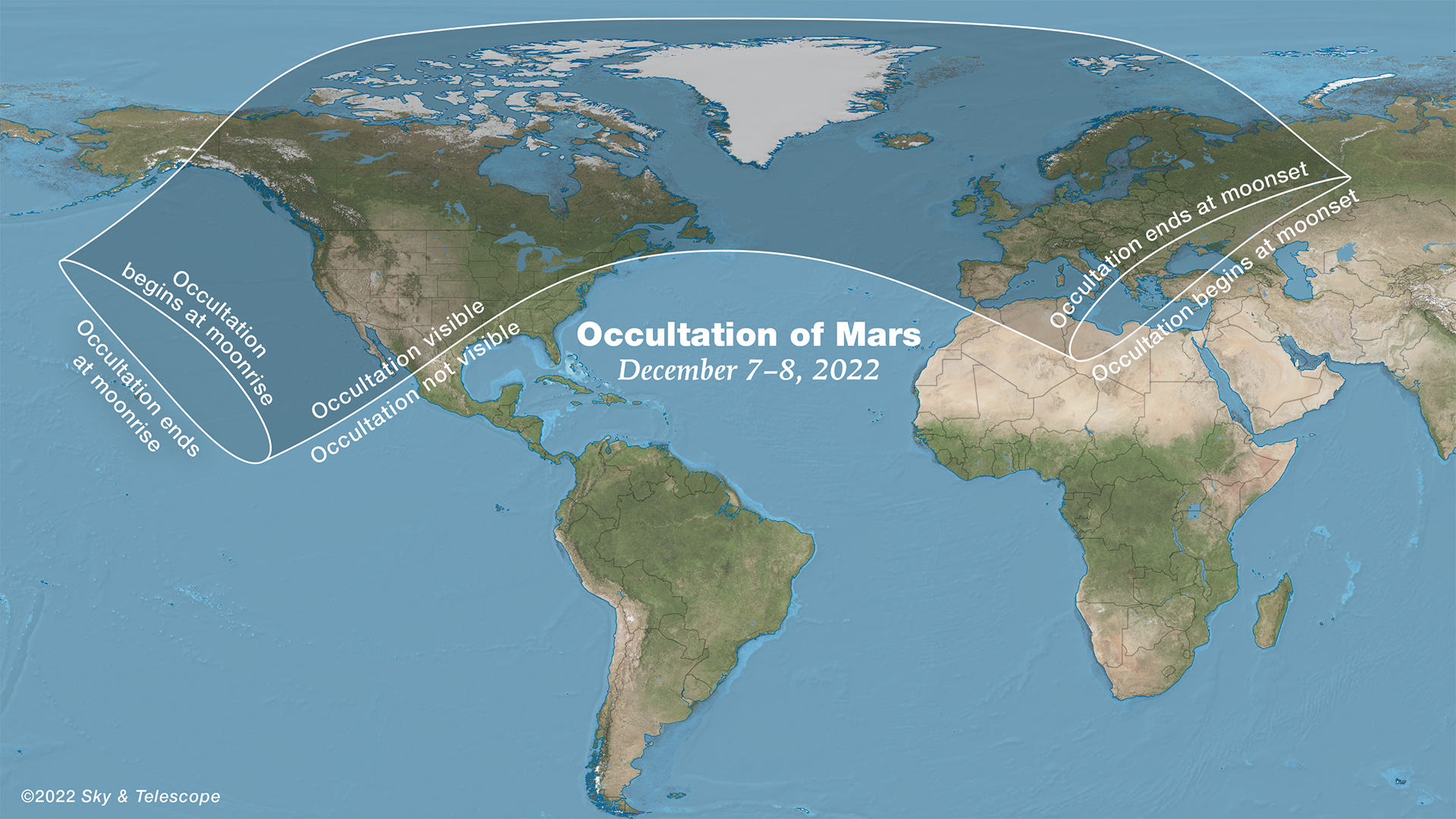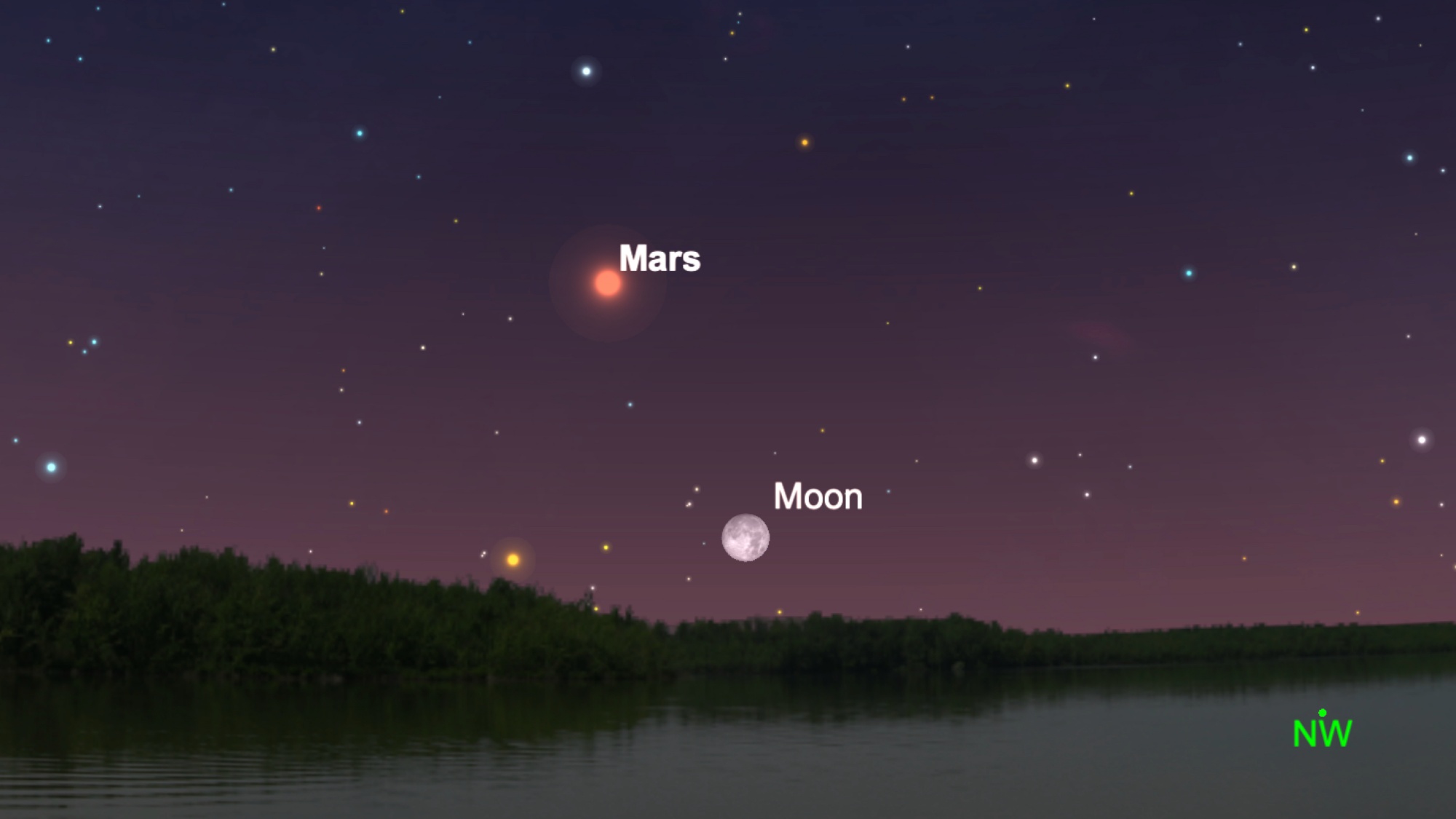What time will the full moon eclipse Mars on Dec. 7?
Here's a timeline for the lunar occultation of Mars on Wednesday (Dec. 7).
Update for Dec. 8: The rare Mars eclipse by the full moon thrilled skywatchers around the world. See photos and video of the Mars occultation. Also, don't miss your second chance to see Mars on Dec. 8 during these Mars opposition webcasts!

Want to get a better look at Mars as it disappears behind the moon? We recommend the Celestron Astro Fi 102as the top pick in our best beginner's telescope guide. Don't forget a moon filter if you'll be looking towards our celestial companion.
This week offers an excellent opportunity to view Mars in the night sky as it puts on quite a show for observers on Earth.
This week, the Red Planet is at opposition, meaning it forms a straight line with Earth and the sun, with Earth in the middle. In this alignment, Mars will appear brighter than usual and be much easier to see in the sky. Mars is at opposition just once every 26 months. In addition to being at opposition, this week will also see a lunar occultation of Mars on Wednesday evening (Dec. 7). An occultation is an event in which one object appears to pass behind another in the sky, completely disappearing from view. In this case, Mars will disappear behind the moon and reappear an hour later.
The lunar occultation of Mars will begin shortly after sundown on Wednesday for viewers in North America, while skywatchers in Europe and parts of North Africa will be able to witness the spectacle shortly before sunrise in the morning hours of Thursday (Dec. 8). If you're unable to get outside during that time or if skies in your area are cloudy, you can watch the lunar occultation of Mars online for free, courtesy of several webcasts from observatories around the world. If conditions in your area are right to see the event in person, check out our tables below on optimal viewing times based on your location.
Related: Mars at opposition will meet up with the full moon next week (Dec. 7). Here's how to see it
The lunar occultation of Mars will be visible for most of North America, Europe and a few areas in northern Africa and the Middle East. Sky & Telescope has put together a thorough guide on the event, including the map below showing viewing locations and rough times for viewing the occultation of Mars.
The table below lists the times of Mars' disappearance and reappearance from behind the moon as seen from various locations throughout North America. These times can vary considerably. For example, if Mars passes behind the moon's larger central area from your vantage point, it may be covered for an hour or more. But if the Red Planet slides behind the moon's lower edge, it could be covered for less than a half hour. Disappearance and reappearance times listed below are for Mars' center.
Breaking space news, the latest updates on rocket launches, skywatching events and more!
The table below provides specific occultation viewing times for 27 selected cities in the United States and Canada. For times with an asterisk (*), the calendar date is Dec. 8.
| Location | Time zone | Mars disappears | Mars reappears |
|---|---|---|---|
| Juneau | AKST | 6:19 p.m. | 6:55 p.m. |
| Los Angeles | PST | 6:30 p.m. | 7:30 p.m. |
| San Francisco | PST | 6:34 p.m. | 7:35 p.m. |
| Seattle | PST | 6:51 p.m. | 7:50 p.m. |
| Vancouver | PST | 6:55 p.m. | 7:52 p.m. |
| Tucson | MST | 7:32 p.m. | 8:27 p.m. |
| Las Vegas | PST | 7:34 p.m. | 8:35 p.m. |
| Salt Lake City | MST | 7:41 p.m. | 8:46 p.m. |
| Denver | MST | 7:44 p.m. | 8:48 p.m. |
| Helena | MST | 7:51 p.m. | 8:56 p.m. |
| Edmonton | MST | 8:04 p.m. | 9:06 p.m. |
| Yellowknife | MST | 8:23 p.m. | 9:16 p.m. |
| Whitehorse | MST | 8:25 p.m. | 8:57 p.m. |
| Tulsa | CST | 8:54 p.m. | 9:41 p.m. |
| Kansas City | CST | 8:56 p.m. | 9:52 p.m. |
| Austin | CST | 8:57 p.m. | 9:12 p.m. |
| Saskatoon | CST | 9:03 p.m. | 10:10 p.m. |
| Winnipeg | CST | 9:05 p.m. | 10:16 p.m. |
| Chicago | CST | 9:10 p.m. | 10:04 a.m. |
| Memphis | CST | 9:14 p.m. | 9:29 p.m. |
| Churchill | CST | 9:22 p.m. | 10:31 p.m. |
| Louisville | EST | 10:21 p.m. | 10:47 p.m. |
| Toronto | EST | 10:29 p.m. | 11:17 p.m. |
| Montreal | EST | 10:40 p.m. | 11:29 p.m. |
| Quebec City | EST | 10:45 p.m. | 11:36 p.m. |
| Halifax | AST | 12:15 a.m.* | 12:33 a.m.* |
| Gander | NST | 12:47 a.m.* | 1:37 a.m.* |
Even if you are outside of the viewing area for the occultation, you will still be able to see the moon and Mars in a close approach of one another known as an appulse.
The table below provides times and locations for Mars' closest approach to the lower edge of the moon during the event. Separation between Mars and the moon's lower edge is given in terms of minutes of arc. (The apparent width of the moon on Dec. 7 is 30 arc minutes.)
For times with an asterisk (*), the calendar date is Dec. 8.
| Location | Time zone | Closest approach | Separation |
|---|---|---|---|
| New Orleans | CST | 9:11 p.m. | 3 arc min. |
| Huntsville | CST | 9:23 p.m. | 1 arc min. |
| Miami | EST | 10:16 p.m. | 11 arc min. |
| Jacksonville | EST | 10:23 p.m. | 7 arc min. |
| Atlanta | EST | 10:26 p.m. | 3 arc min. |
| Columbia | EST | 10:31 p.m. | 4 arc min. |
| Knoxville | EST | 10:31 p.m. | 1 arc min. |
| Charlotte | EST | 10:36 p.m. | 3 arc min. |
| Norfolk | EST | 10:46 p.m. | 4 arc min. |
| Washington | EST | 10:46 p.m. | 2 arc min. |
| Philadelphia | EST | 10:51 p.m. | 1 arc min. |
| New York | EST | 10:56 p.m. | 1 arc min. |
| Boston | EST | 11:01 p.m. | 0.6 arc min. |
| San Juan | AST | 11:51 p.m. | 23 arc min. |
| Hamilton | AST | 12:06 a.m.* | 11 arc min. |
If you miss the lunar occultation of Mars on Dec. 7, you'll have to wait until January 2025 for the next one, so even if you can't make it outside, make sure to watch Mars at opposition pass behind the moon in one of the free livestreams available online.
If you're an avid skywatcher or even if you're just getting started, make sure to read our guides for the best binoculars and the best telescopes to view the occultation of Mars and other incredible things in the night sky. For capturing the best pictures of Mars or the moon that you can, don't miss our recommendations for the best cameras for astrophotography and best lenses for astrophotography.
Editor's Note: If you snap a great photo of either Mars at opposition or the lunar occultation and would like to share it with Space.com's readers, send your photo(s), comments, and your name and location to spacephotos@space.com.
Follow us on Twitter @Spacedotcom or on Facebook.

Brett is curious about emerging aerospace technologies, alternative launch concepts, military space developments and uncrewed aircraft systems. Brett's work has appeared on Scientific American, The War Zone, Popular Science, the History Channel, Science Discovery and more. Brett has English degrees from Clemson University and the University of North Carolina at Charlotte. In his free time, Brett enjoys skywatching throughout the dark skies of the Appalachian mountains.


